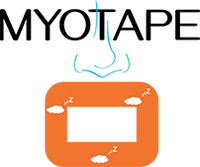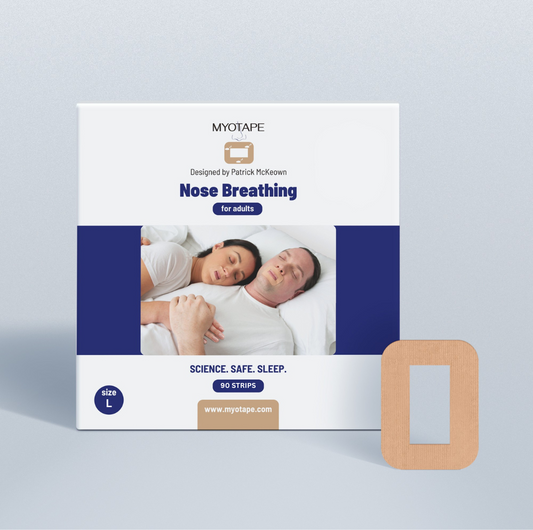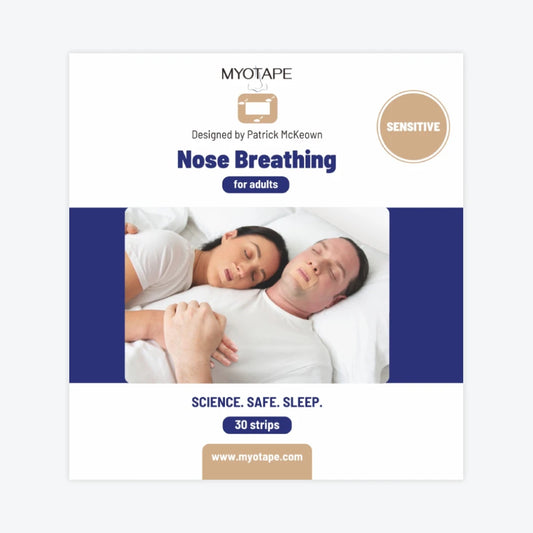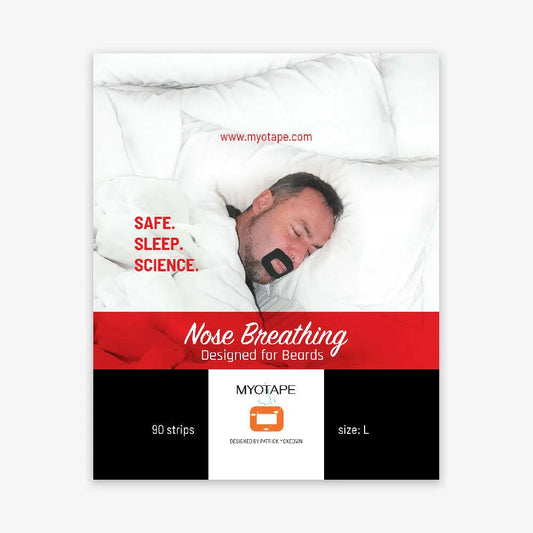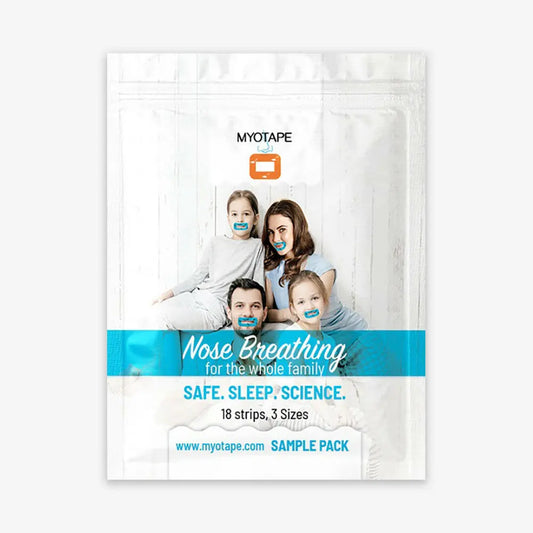Did you know that an estimated 936 million adults globally suffer from mild to severe obstructive sleep apnea? This condition not only disrupts sleep but can lead to serious health problems like heart disease, diabetes, and stroke. Sleep apnea affects approximately 15-30% of males and 10-15% of females in North America alone.
For those dealing with this condition, finding an effective treatment is crucial. Continuous Positive Airway Pressure (CPAP) machines have long been the gold standard, providing relief by keeping airways open during sleep.
However, CPAP is not without its challenges. This is where mouth tape comes in—a simpler, complementary treatment that can work together with CPAP therapy to enhance its effectiveness and improve sleep quality.
In this article, we'll explore how mouth tape and CPAP can be used together to combat sleep apnea. By the end, you'll have a clearer understanding of how they complement each other, helping you or your loved one make an informed decision and, ultimately, achieve better sleep and health. Let's begin by briefly explaining sleep apnea.
What You Need to Know About Sleep Apnea
Sleep apnea is a serious sleep disorder characterized by repeated interruptions in breathing during sleep. These interruptions can lead to poor sleep quality and various health issues.
There are two main types of sleep apnea: obstructive sleep apnea (OSA) and central sleep apnea. However, the most common type is obstructive sleep apnea.
Obstructive Sleep Apnea (OSA) is the most common form of sleep apnea. It occurs when the muscles in the throat relax excessively during sleep, causing the airway to become blocked.
This blockage leads to breathing pauses that can last for 10 seconds or more. OSA affects up to 9% of women and 26% of men between the ages of 30 and 49 and up to 27% of women and 43% of men aged 50 to 70. People with OSA often snore loudly and experience episodes of shallow breathing (hypopnea) and complete pauses in breathing (apnea).
Symptoms and Health Risks
The symptoms of OSA can significantly impact daily life and overall health. Common symptoms include:
- Daytime tiredness and fatigue
- Limited ability to concentrate
- Sudden awakenings, sometimes with a racing heart or feeling of breathlessness
- Dry mouth upon waking
- Night sweats and frequent need to urinate
- Morning headaches
- Potential impotence and erectile dysfunction in men
The health risks associated with untreated sleep apnea are severe and include:
- Increased risk of cardiovascular issues such as high blood pressure, heart attack, and stroke
- Higher likelihood of metabolic disorders like diabetes
- Elevated risk of sudden cardiac death, particularly during sleep
- Greater chances of being involved in motor vehicle accidents due to fatigue.
It is important to add that mouth breathing has been strongly linked to causing and worsening sleep apnea. According to a 2006 study, mouth breathing significantly contributes to Obstructive Sleep Apnea (OSA) in people without nasal blockages. Those with sleep apnea often breathe more through their mouth or both mouth and nose, unlike people who only snore. The severity of sleep apnea, indicated by the Apnea-Hypopnea Index (AHI), is closely linked to how much time is spent breathing through an open mouth. A 2020 study in Laryngoscope confirmed this, showing that mouth breathing leads to worse OSA and lower oxygen levels compared to nasal or mixed breathing.
Importance of Seeking Treatment
Getting treatment for sleep apnea is crucial to prevent these serious health risks and improve quality of life. Despite the availability of effective treatments, many people with OSA remain undiagnosed and untreated. This may be due to a lack of awareness, fear of lifestyle changes, or concerns about existing treatment options.
A sleep study is essential for anyone concerned if they may have sleep apnea. Sleep studies conducted at hospitals and sleep centers worldwide are the best way to determine if you have mild, moderate, or severe sleep apnea. These studies comprehensively assess your sleep patterns and help your doctor diagnose the condition accurately.
Effective treatment can significantly reduce symptoms and health risks associated with this condition, and the foremost treatment for sleep apnea is CPAP therapy.

CPAP Therapy
Continuous Positive Airway Pressure (CPAP) therapy is a widely used treatment for moderate to severe Obstructive Sleep Apnea (OSA). The purpose of CPAP is to keep the airway open during sleep, preventing interruptions in breathing and improving sleep quality.
How CPAP Works
- Continuous Positive Airway Pressure: CPAP machines deliver a steady stream of air through a mask worn over the nose or both the nose and mouth. This continuous airflow keeps the airway open, preventing it from collapsing during sleep.
- Equipment and Usage: CPAP therapy involves using a machine, a hose, and a mask. The mask fits comfortably over the nose or nose and mouth, and the machine provides a continuous flow of air. While getting used to the equipment may take some time, many users find significant relief from their sleep apnea symptoms.
Effectiveness in Treating Moderate to Severe Sleep Apnea
CPAP therapy is highly effective in treating moderate to severe sleep apnea. It helps reduce the frequency of apnea episodes, improves oxygen levels, and enhances overall sleep quality. Many patients experience a significant improvement in their daytime alertness and overall health after starting CPAP therapy.
Why CPAP Therapy Alone Might Not Be Enough

CPAP devices have been around since 1981 when Australian doctor Colin Sullivan invented them. This has been the gold standard for treating moderate to severe OSA. It works by providing a continuous stream of air that keeps the airway open, preventing collapses that cause apneas. Numerous studies have confirmed CPAP's effectiveness in reducing apnea episodes, improving oxygen levels, and enhancing overall sleep quality.
However, despite its effectiveness, CPAP therapy has some significant limitations, which are discussed below:
Low Compliance Rates
Sticking with CPAP therapy can be quite challenging for many patients. About 50% of the users discontinue their CPAP device within a year. The reasons for this are varied. Some find the device uncomfortable to wear, while others struggle with the inconvenience of setting it up every night. The sensation of being tethered to a machine can also be off-putting, making it difficult for many to maintain long-term use.
Maintenance and Cleaning
Another challenge with CPAP therapy is the need for regular maintenance. The device and its components must be cleaned frequently to prevent the buildup of harmful microorganisms such as spores and fungi. If these microorganisms accumulate, they can be inhaled into the lungs, posing serious health risks. This additional responsibility can be burdensome and is often a deterrent for consistent use.
Facial Structure Changes
The mask must fit tightly against the face for CPAP therapy to be effective. However, wearing a tight mask every night over long periods can lead to changes in facial structure, sometimes called "smashed face syndrome." This can cause discomfort and may even lead to more serious issues, making the therapy less appealing for long-term use.
Safety and Risks
CPAP therapy, though effective, can have side effects. Common issues include discomfort from the mask, skin irritation, nasal congestion, and dry mouth. Some users may find it challenging to adhere to CPAP therapy due to these discomforts, leading to inconsistent use and reduced effectiveness.
Not Easy to Use
CPAP therapy involves using a machine, a hose, and a mask. While effective, the equipment can be cumbersome and uncomfortable for some users. Adapting to CPAP therapy may take time, and finding the right mask fit is crucial for comfort.
Low Adherence
CPAP therapy requires a higher level of commitment. Acceptable CPAP adherence is defined as using the device for at least 4 hours per night 70 of the time. However, studies show that using CPAP for more than 6 hours per night is necessary to reduce cardiovascular risks. Mouth breathing can compromise CPAP effectiveness, making it essential to address this issue for better compliance.
Despite all these challenges, it would interest you to know that both mouth tapes and CPAP complement each other and can be used together. Let's consider how mouth tapes and CPAP can work together to fight sleep apnea.

How Mouth Tapes and CPAP Work Together to Fight Sleep Apnea
Understanding the unique benefits of both mouth taping and CPAP therapy can be empowering for those struggling with sleep apnea. While CPAP remains the most effective treatment for moderate to severe cases, ensuring its effectiveness can sometimes be challenging, particularly for mouth breathers. This is where mouth taping can play a crucial role and help you immensely.
Mouth taping is a simple technique where medical tape is placed over the lips before sleep to encourage nasal breathing while sleeping. By keeping the mouth closed, this method helps improve breathing patterns, eliminate mouth breathing, and reduce snoring. Nasal breathing is more natural and beneficial, as it filters and humidifies the air, making breathing easier.
Combining mouth taping with CPAP therapy can enhance treatment outcomes for sleep apnea patients. Mouth taping helps ensure that the air provided by the CPAP machine reaches the airway as intended, reducing air leaks and preventing sleep fragmentation. This combination can lead to improved CPAP compliance, better sleep quality, and reduced health risks associated with sleep apnea.
In fact, a study found that mouth breathing reduces the effectiveness of CPAP therapy. The study included 51 new CPAP users with moderate-to-severe sleep disorders. It showed that patients who breathed mainly through their mouths during sleep had more air leaks and were less likely to stick with CPAP therapy compared to those who breathed through their noses.
After one year, 71% of nose breathers used CPAP for more than 4 hours a night, while only 30% of mouth breathers did the same. Mouth breathing also decreased significantly from 84% to 22% after three months of CPAP use.
These results suggest that using mouth tape with CPAP can greatly improve treatment. Mouth taping helps keep the mouth closed which stops CPAP dry mouth, encourages nasal breathing, reduces air leaks, and ensures the CPAP machine works as intended.
This combination can improve adherence to CPAP therapy, leading to better sleep and overall health.
Can Mouth Tapes Be Used Alongside Mandibular Advancement Devices?
In addition to CPAP, mouth tapes can also be used along with Mandibular Advancement Devices (MAD) and can also increase their effectiveness in managing sleep apnea.
MADs are small plastic devices made by a dentist that fits in your mouth like a mouth guard or orthodontic retainer. It is another common treatment for OSA patients. They work by pulling the lower jaw (mandible) and tongue forward, helping to keep the airway open during sleep. While MADs are effective in improving symptoms for many users, they can sometimes lead to increased mouth breathing during sleep.
This is how mouth taping can help because it promotes mouth closure and encourages nasal breathing, enhancing the efficacy of the MAD and ensuring that the airway remains open and stable throughout the night.
Another interesting thing to know about OSA is a phenomenon known as mouth puffing. Mouth puffing happens when someone breathes out through their mouth during sleep, either occasionally or all night. This is common in people with obstructive sleep apnea (OSA) due to nasal blockage or relaxed throat muscles. Using a mouth tape like MyoTape, which allows for mouth puffing, is important for managing OSA. It helps keep the mouth closed to encourage nasal breathing while letting the body breathe naturally when needed.
A mouth tape that completely covers the mouth could potentially worsen sleep apnea symptoms. However, using a mouth tape like MyoTape, which allows for some mouth puffing, can help mitigate this issue while still promoting nasal breathing.
MyoTape + CPAP Can Help You Beat Sleep Apnea
Choosing the perfect mouth tape reduces sleep apnea symptoms and ensures CPAP adherence. MyoTape is the most effective mouth taping solution for combating sleep apnea. Renowned breathing expert, Patrick McKeown invented MyoTape, a simple and safe mouth taping solution that restores nasal breathing and ensures optimal CPAP function throughout the night.
What makes MyoTape great is its unique and innovative design. It does not cover the lips entirely, allowing for emergency opening and mouth puffing to take place if necessary as it is worn surrounding the lips and does not cover the mouth. Mouth puffing is important for sleep apnea patients and any mouth tape that doesn't allow it could worsen the condition.
With MyoTape, the elastic tension from the tape helps bring the lips together to ensure nasal breathing and enhances overall sleep quality. View our unique selection of mouth tapes in the online store and choose the perfect fit for you. We have mouth tapes for adults, for sensitive skin, for beards, and for kids.
